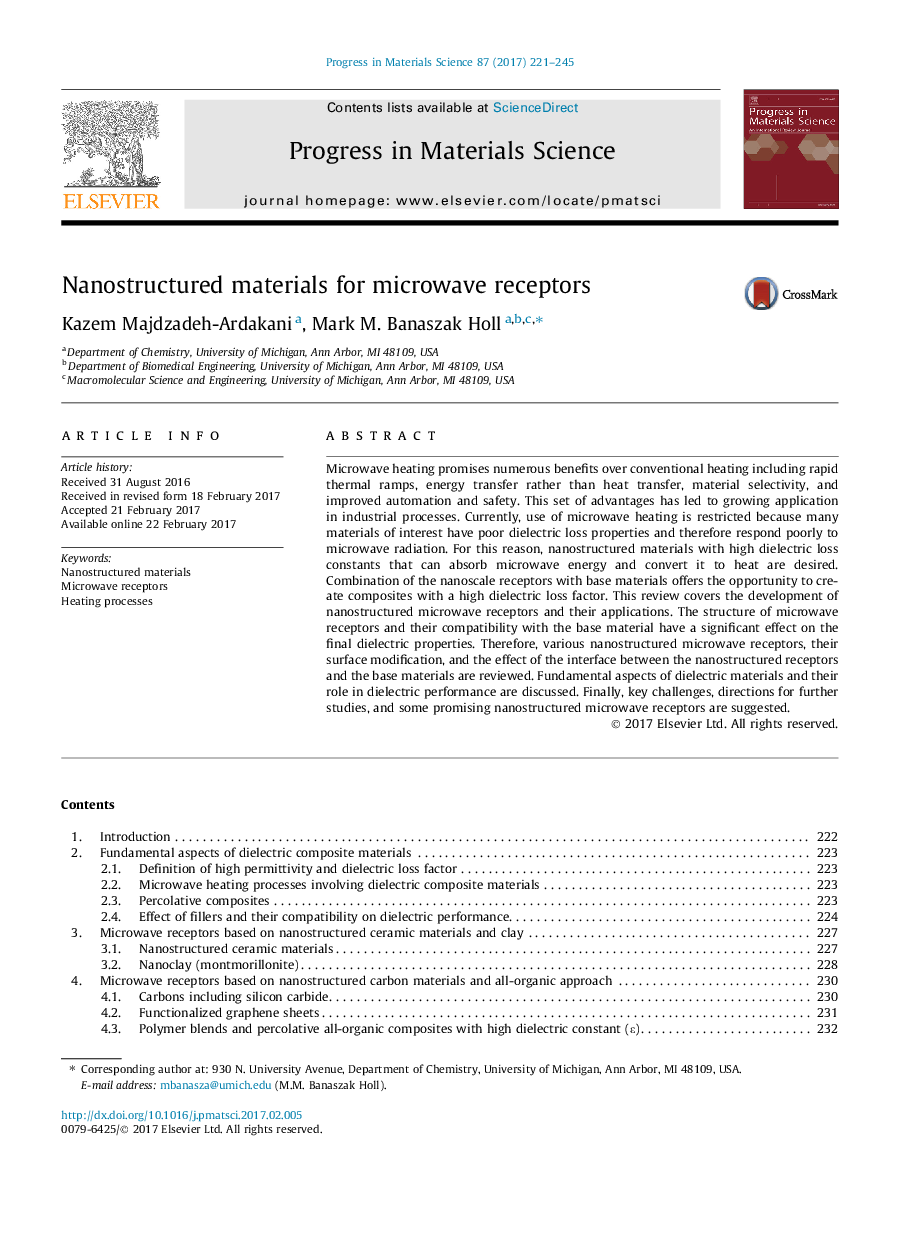| کد مقاله | کد نشریه | سال انتشار | مقاله انگلیسی | نسخه تمام متن |
|---|---|---|---|---|
| 5464311 | 1517427 | 2017 | 25 صفحه PDF | دانلود رایگان |
عنوان انگلیسی مقاله ISI
Nanostructured materials for microwave receptors
ترجمه فارسی عنوان
مواد نانوساختار برای گیرنده های مایکروویو
دانلود مقاله + سفارش ترجمه
دانلود مقاله ISI انگلیسی
رایگان برای ایرانیان
کلمات کلیدی
مواد نانوساختار، گیرنده های مایکروویو، فرایندهای حرارت،
ترجمه چکیده
گرمایش مایکروویو مزایای متعددی نسبت به حرارت معمولی دارد از جمله رمپ های حرارتی سریع، انتقال انرژی به جای انتقال حرارت، انتخاب مواد و بهبود خودکار و ایمنی. این مجموعه مزایا منجر به افزایش استفاده در فرایندهای صنعتی شده است. در حال حاضر استفاده از گرمایش مایکروویو محدود است، زیرا بسیاری از مواد مورد علاقه خواص ضعیف دی الکتریک ضعیف است و بنابراین به مایکروویو تابش بدی دارند. به همین علت، مواد نانوساختار با ثابت های از دست دادن دی الکتریک بالا که قادر به جذب انرژی مایکروویو و تبدیل آن به گرما هستند، مورد نظر است. ترکیبی از گیرنده های نانومقیاس با مواد پایه، فرصتی برای ایجاد کامپوزیت ها با یک عامل از دست دادن دی الکتریک بالا است. این بررسی، توسعه گیرنده های نانوساختار مایکروویو و برنامه های کاربردی آنها را پوشش می دهد. ساختار گیرنده های مایکروویو و سازگاری آنها با مواد پایه تأثیر قابل توجهی بر خواص نهایی دی الکتریک دارند. بنابراین، گیرنده های مختلف نانوساختار مایکروویو، اصلاح سطح آنها و اثر رابط بین گیرنده های نانوساختار و مواد پایه بررسی شده است. جنبه های بنیادی مواد دی الکتریک و نقش آنها در عملکرد دی الکتریک مورد بحث قرار گرفته است. در نهایت، چالش های اصلی، جهت مطالعات بیشتر و برخی از گرافت های مایکروویو نانوساختار امیدوار کننده پیشنهاد می شود.
موضوعات مرتبط
مهندسی و علوم پایه
مهندسی مواد
فناوری نانو (نانو تکنولوژی)
چکیده انگلیسی
Microwave heating promises numerous benefits over conventional heating including rapid thermal ramps, energy transfer rather than heat transfer, material selectivity, and improved automation and safety. This set of advantages has led to growing application in industrial processes. Currently, use of microwave heating is restricted because many materials of interest have poor dielectric loss properties and therefore respond poorly to microwave radiation. For this reason, nanostructured materials with high dielectric loss constants that can absorb microwave energy and convert it to heat are desired. Combination of the nanoscale receptors with base materials offers the opportunity to create composites with a high dielectric loss factor. This review covers the development of nanostructured microwave receptors and their applications. The structure of microwave receptors and their compatibility with the base material have a significant effect on the final dielectric properties. Therefore, various nanostructured microwave receptors, their surface modification, and the effect of the interface between the nanostructured receptors and the base materials are reviewed. Fundamental aspects of dielectric materials and their role in dielectric performance are discussed. Finally, key challenges, directions for further studies, and some promising nanostructured microwave receptors are suggested.
ناشر
Database: Elsevier - ScienceDirect (ساینس دایرکت)
Journal: Progress in Materials Science - Volume 87, June 2017, Pages 221-245
Journal: Progress in Materials Science - Volume 87, June 2017, Pages 221-245
نویسندگان
Kazem Majdzadeh-Ardakani, Mark M. Banaszak Holl,
